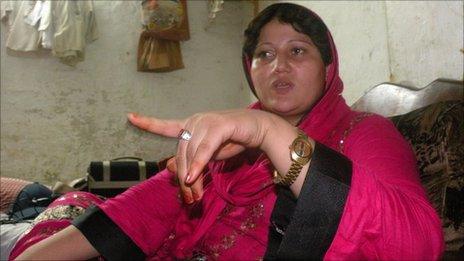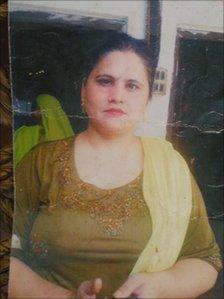The decline of Swat's celebrated dancing girls
- Published

Tasleem says business is slow and there are fewer dancers nowadays
Live music, whisky, and traditional performances from celebrated dancing girls was how the evenings used to unfold in the renowned music district of Bunrh in Pakistan's Swat valley.
But four years ago the region was captured by Taliban militants and remained under their control until they were driven out by the Pakistani army in 2009.
And when the bullet-riddled body of one of the most famous of Swat's dancing girls was found in the main square, the musicians and dancers fled.
Many have since returned but their previous carefree existence is now just a memory. The problem is that Swat has also been affected by growing conservatism in Pakistani society.
There are few customers - dance-watchers known as tamashbeen - and there are even fewer dancing girls left.
The men roaming the narrow lanes of Bunrh, who control admission into the dance houses, receive strangers with folded arms and suspicious looks. Admission into a house of dancers is impossible without a good local reference to ensure one is simply seeking entertainment.
Once that is arranged, many men are disappointed to learn that no liquor is served and there is no live music.
'Making ends meet'
The atmosphere is subdued. Where a whole troupe used to perform, the hostess now dances to music played on a cassette recorder.
The evening used to begin with an instrumental called Logorai, a slow halt-and-flow melody named after the Afghan province of Logar. Pashto folk songs would be sung on the themes of love, separation and travels to far-off lands.
As the evening progressed, the music would become more high-tempo. The dancers would dance barefoot wearing ankle bells.
"Previously business used to be great here; there was good money in it, everybody was happy," 30-year-old Tasleem says.
"But now it's different. Now it's all about making ends meet."
She recalls the time when money and alcohol flowed freely and life had a more liberal flavour. Once the Taliban came, musicians and dancers experienced a gradual squeeze on their sources of income.
The lucrative invitations to dance at weddings and private parties became few and far between.
Music videos, that once brought hefty fees to the singers and dancers of Bunrh, became a dangerous occupation because the Taliban saw them as the living proof of their "immorality".
Musicians, mostly male relatives of the dancing girls, got rid of their music instruments fearing the Taliban may raid their houses and find them.
"We had been ordered by Taliban to quit our profession, and everybody had complied and switched to other odd jobs to make a living," says Tasleem.
But many of the dancing girls across Pakistan are born into the trade. There are few options for them in mainstream society so they have no choice but to take up the family business of looking decorative and dancing for strangers.
Shabana's murder
Like most of the other dancers and musicians in the Swat valley, Tasleem fled in the autumn of 2008 following the brutal murder of her fellow performer, Shabana.
"When they killed our neighbour, Shabana, everybody decided to leave that same day. We fled in panic, leaving everything behind, even our shoes and clothes."

Shabana was killed brutally by the Taliban
Shabana was 25-years-old and had violated the Taliban's ban on song and dance. The Taliban broke into her house on a chilly winter night in January 2009.
"They broke the outer gate of the house, and then sawed their way through other doors," recalls Ziarat Gul, one of Shabana's four brothers.
They dragged all 22 members of the family, including 14 children, from their beds and herded them into the kitchen.
"One of them asked, which one is Shabana? Another man caught her by the wrist and said, this is her," says Ziarat Gul.
The men dragged her away, saying they wanted to ask her some questions and would let her go soon.
Mr Gul says he tried to follow them, but one of the men turned around "and said he'd put a hole in my head if I didn't turn back".
The family waited until the first light of dawn, then Mr Gul went out to look for her.
"I found her lying near the Grain Square. She was dead. She was shot six times, and one of her arms was broken in three places."
Ambition dead
Although they have been back for two years, the horror of those times still lingers in the minds of many. One of them is Neelum, a 25-year-old singer and dancer.
When I last met her in 2007, she was hugely popular for her music videos and she aspired to act in Pakistani movies.
But the only entertainment she offers now is a discreet dance - to music played in low volume on a tape recorder - within the privacy of her home.
She appears to have lost her ambition and her youthful enthusiasm. I ask her if she still cherishes the dream of becoming the video queen of northern Pakistan.
"I haven't done music videos since we fled Mingora," she says.
"I have been approached by some producers but I refused. The fear doesn't leave me that if I start doing videos, the Taliban will return to punish me."
When the Taliban influence first began to spread to the area, before they captured it, many dancers were married off by their families and thereby quit the profession. Tasleem said the few girls left dancing were the ones whose families depend on the income they can generate.
Even Shabana was set to be married. Her brother said that he had promised her hand to a government contractor who had asked for six months to raise money for the wedding.
She was killed before that could happen.
Although few in Swat expect the Taliban to stage a comeback, the scars they left on the society are not likely to heal quickly.